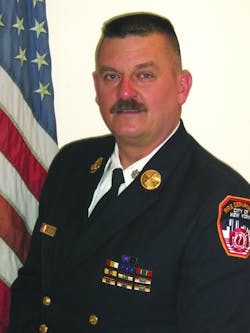There are many actions and tactics that need to be handled at structural fires. If you break down all of them, the list could include receiving the alarm, response, size-up, assuming command, establishing water supply, forcible entry, fire attack, search and rescue, ventilation and overhaul. In addition to the fact that there are numerous actions required, there are several ways to complete or perform each of them. Let’s take a look at firefighters operating above the fire.
Operating above the fire is handled in different ways in different types of buildings. Operations are adjusted based on the style or design of the building, the type of construction, the size of the building and the location and extent of the fire.
Consider a multi-story apartment house. This building could be constructed of brick and joist or it could be a wood-frame. It could be three, four or even six stories tall. There could be several apartments on each floor, and the interior stairway could terminate on the top floor or up on the roof.
One of the most effective and helpful tactics that can be taken at a multi-story building is getting a crew or company to the floor above the fire. This “floor above” team has a long list of tasks that need to be accomplished, all of which can have a dramatically positive impact on the overall outcome of the fire.
Some of you are asking, “Does this ‘floor above’ team go above the fire without a hoseline?” The answer is yes. This is a search team—not a fire control team. Stretching and dragging a charged hoseline into and up to the floor above the fire will dramatically slow down the entire search operation. Additionally, if a three- or four-person team enters, they may very well separate inside an apartment, meaning the hoseline would only protect one part of the team. Obviously a hoseline is a great way to keep this team safe from fire while operating above, but there are other ways to reduce the hazard.
The first action that the “floor above” team needs to do is inform the first-due engine crewmembers (who are fighting the fire on the fire floor) that they are going above. With that done, the engine officer can warn that team if they lose control of the fire floor or if the fire continues to grow and threaten them on the floor above.
The team must then get to the floor above, orient themselves and identify the apartment that is directly above the fire apartment on the fire floor. Once this is done, they can force the door on the opposite side of the hallway and secure an area of refuge in case they need to rapidly evacuate the hallway. These two actions allow the “floor above” team to go to work on the floor above with some degree of safety.
The team should then enter and begin their search. What are they searching for? Both fire and life. Their search starts at the door, and if there are enough members, they can separate and search in two different directions. If there are reports of people trapped above, they can move quickly toward the bedrooms (if at night) or toward the area or room above the fire. Remember that this apartment or area is not on fire. This is the area above. There will be considerable heat and smoke, and in many ways it may feel like you are in the fire area, but you are not.
The search team must get to the area or room above the fire and examine it for extension. If the fire is serious, there is a great possibility of fire extending up through the floors, baseboard molding, pipe recesses and electrical wire channels. The search for victims and fire is accomplished simultaneously. After rapidly determining that there are no victims, the search can be concentrated on examining the floors, baseboards and voids.
Getting a search team above the fire without a hoseline is a tactic that does have its hazards, but it also allows for the rapid discovery of savable victims. Fire departments that practice this tactic successfully rescue many victims every year. Additionally, many fires are confined to the original fire floor and held to the initial alarm because the “floor above” team rapidly locates the first area of extension that the fire is following and it is rapidly extinguished.






